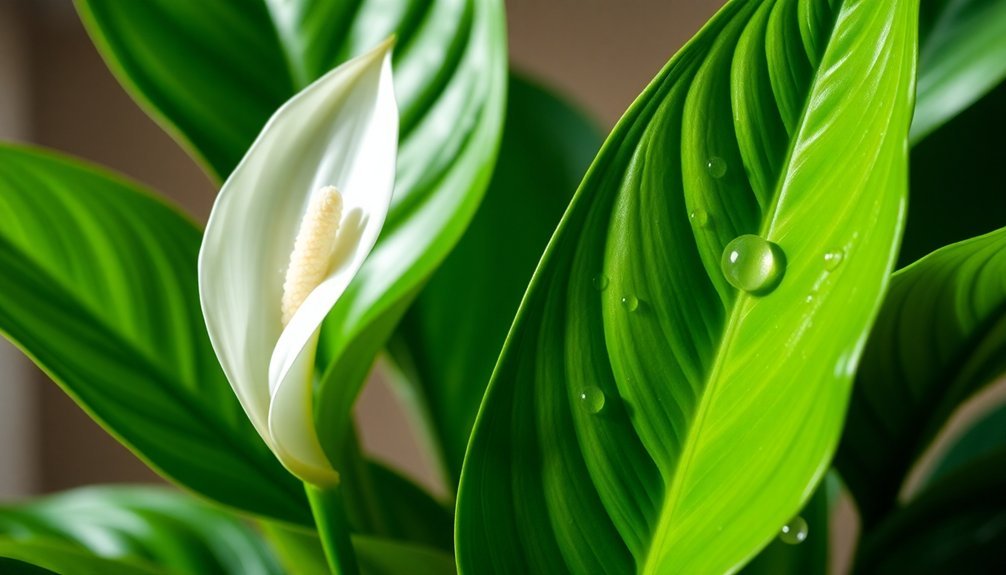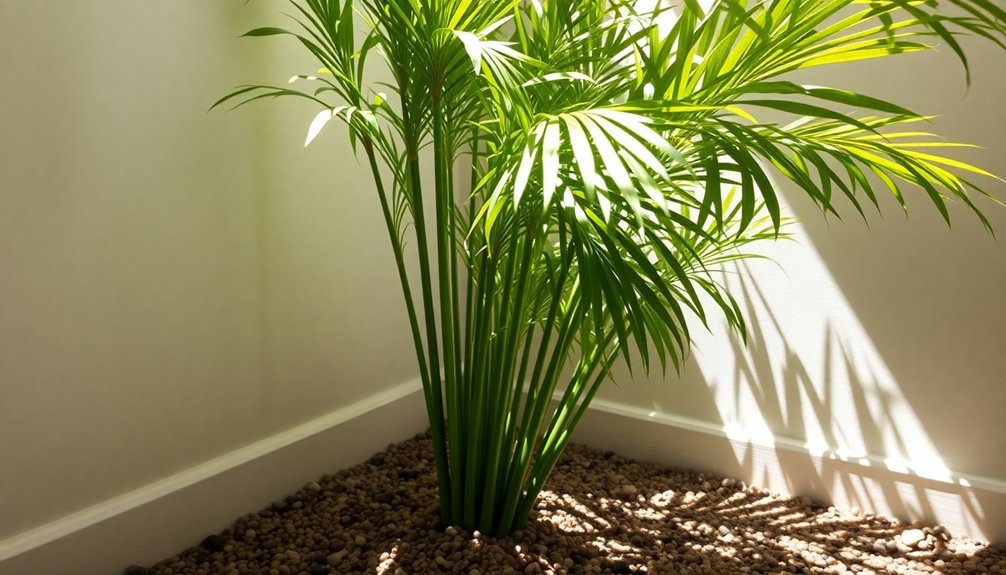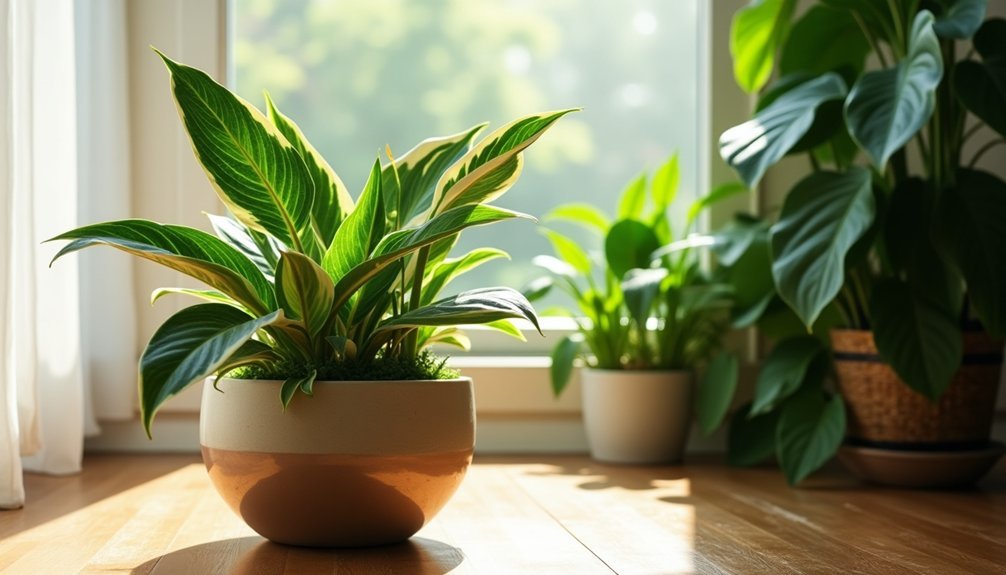Transform your home's air quality with nature's most effective living purifiers. You'll find garden mums remove up to 50% of VOCs, while spider plants efficiently filter airborne particles. Peace lilies absorb toxins and increase humidity, as snake plants release oxygen at night. Don't forget bamboo palms, dracaena, and aloe vera – each bringing unique air-cleaning abilities. Discover how these seven powerful plants can create your healthiest living space yet.
Garden Mums: Nature's Air Filtering Champions

Three remarkable qualities make garden mums a standout choice for natural air purification in your home. First, these powerful indoor air filters can remove up to 50% of VOCs, including harmful substances like formaldehyde and benzene.
Garden mums stand as nature's air-purifying champions, filtering out up to half of indoor VOCs like formaldehyde and benzene.
Second, you'll enjoy their aesthetic appeal while they work tirelessly to improve your air quality.
Third, they're incredibly easy to maintain.
You can maximize your garden mums' air-filtering potential by placing them in areas with full sunlight and well-drained soil. During their flowering period, which can last several weeks, they'll continuously cleanse your indoor environment of air pollutants.
This natural air purification solution offers you a beautiful and effective way to create a healthier living space. Whether you're focused on air quality or home décor, garden mums deliver outstanding results on both fronts.
Spider Plants: The Resilient Air Cleaners
Beyond their remarkable air-purifying abilities, spider plants serve as beautiful hanging or tabletop displays that can instantly elevate your home's aesthetic.
You'll find these versatile plants require minimal attention, thriving in indirect light with occasional watering, making them perfect for both novice and experienced plant enthusiasts.
Their ability to self-propagate means you can easily expand your collection of natural air purifiers by replanting the "babies" that sprout from the mother plant, creating a sustainable and cost-effective solution for cleaner indoor air.
Benefits Beyond Air Purification
While spider plants excel at purifying indoor air, their benefits extend far beyond their remarkable filtering capabilities.
You'll find these versatile plants offer exceptional value as they remove airborne particles and formaldehyde while being incredibly energy efficient in their air purification process.
These adaptable plants bring multiple advantages to your living space:
- Easy propagation allows you to multiply your clean air benefits without additional cost.
- Their resilience to varying indoor conditions means consistent air quality improvement with minimal maintenance.
- Non-toxic nature makes them safe around pets, effectively filtering pet dander without risking their health.
- Low maintenance requirements fit perfectly into busy lifestyles while maintaining peak performance.
The combination of these benefits makes spider plants an intelligent choice for anyone seeking a natural, effective way to enhance their home's environment.
Care And Growing Guide
Although spider plants have earned their reputation as natural air purifiers, their care requirements couldn't be simpler.
These resilient air quality champions thrive in various light conditions, making them perfect low maintenance additions to your indoor greenery collection.
You'll find these non-toxic plants exceptionally drought-tolerant, needing water only when the top inch of soil feels dry.
While they're busy filtering pollutants like formaldehyde and xylene from your home, they'll also produce offspring called "pups."
This simple propagation feature lets you expand your collection of air-cleaning plants without spending extra money.
This essential care guide boils down to three basics: provide moderate light, water sparingly, and watch for pups to expand your plant family.
Spider plants reward even novice gardeners with lush growth and cleaner air.
Peace Lilies: Toxin-Absorbing Powerhouses

Since indoor air quality continues to be a growing concern, peace lilies have emerged as a natural solution for homeowners seeking effective air purification.
These remarkable plants serve as natural air purifiers, removing harmful indoor air pollutants while requiring minimal maintenance to thrive in low light conditions.
You'll appreciate these toxin-absorbing benefits of peace lilies:
- Remove up to 60% of indoor pollutants within 24 hours
- Filter out harmful substances like formaldehyde, benzene, and carbon monoxide
- Increase humidity levels naturally, supporting respiratory health
- Adapt easily to various home environments between 65-85°F
To maximize their effectiveness, guarantee proper watering by letting the soil dry between sessions.
Your peace lily won't just improve air quality; it'll create a healthier living space while adding natural beauty to your home.
Snake Plants: Bedroom Air Quality Heroes
The unassuming snake plant stands as a nighttime champion of bedroom air quality. You'll be amazed by its efficient ability to eliminate up to 90% of airborne toxins in just 24 hours, while releasing oxygen as you sleep.
| Feature | Benefit |
|---|---|
| Oxygen Release | Nighttime air purification |
| Toxin Removal | Eliminates formaldehyde, benzene, xylene |
| Maintenance | Minimal care, infrequent watering |
| Light Needs | Thrives in low light conditions |
| Humidity Control | Reduces respiratory problems |
These natural air purifiers are perfect for your bedroom environment, requiring little attention while delivering powerful results. Unlike other plants, snake plants continue their unique photosynthesis process at night, actively improving your indoor air quality. They'll also boost humidity levels naturally, creating a more comfortable sleeping space. If you're seeking a low-maintenance solution for cleaner air, snake plants are your ideal choice.
Bamboo Palm: Natural Humidity Balancers

Place your Bamboo Palms in spaces between 100-200 square feet to maximize their natural humidifying effects, as these moisture-loving plants can raise humidity levels by up to 50%.
You'll get the most benefits from mature palms reaching 4-8 feet tall, which release more moisture through their larger leaf surface area.
If you're working with limited space, group several smaller palms together to achieve similar humidity-balancing results in your home or office.
Optimal Moisture Release Zones
When selecting ideal locations for your Bamboo Palm's moisture-releasing benefits, strategic placement becomes essential for maintaining balanced indoor humidity.
These natural air purifiers work best in areas where you'll maximize their impact on both air quality and comfort levels.
For best moisture release and pollutant filtering, position your Bamboo Palm in these key zones:
- Home offices or study areas where you spend extended hours, helping reduce respiratory discomfort.
- Living rooms with high ceilings, allowing proper air circulation and humidity distribution.
- Bedrooms, where consistent moisture levels can improve sleep quality and breathing.
- Near electronics or heating units that typically dry out the air.
Remember to place your Bamboo Palm in indirect light within these zones to guarantee it thrives while effectively maintaining ideal indoor humidity levels.
Palm Size Impact Guide
Beyond strategic placement, understanding how a Bamboo Palm's size affects its humidity-balancing power helps you choose the right plant for your space.
These living air purifiers pack quite a punch despite their compact size – even a 3-foot Bamboo Palm can boost your room's humidity by up to 20% while filtering harmful pollutants like formaldehyde and benzene.
You'll find that these natural air purifiers don't need much space to deliver impressive environmental benefits. A 4-to-6-foot palm fits perfectly in most corners while actively improving your indoor air quality.
What's more, you won't have to worry about your pets' safety around these plants, as they're completely non-toxic.
Whether you're dealing with dry air in your bedroom or seeking cleaner air in your home office, a Bamboo Palm's size-to-impact ratio makes it an ideal choice.
Dracaena: The Formaldehyde-Fighting Plants
Among nature's most effective air purifiers, Dracaena plants stand out as formidable fighters against formaldehyde in indoor spaces. According to NASA's Clean Air Study, these living air cleaners can reduce formaldehyde levels by up to 30%, making them invaluable for improving your indoor air quality.
Dracaena plants excel at cleaning indoor air, naturally filtering out harmful formaldehyde and making your space healthier to breathe.
You'll love these air-purifying powerhouses because they:
- Thrive in low light conditions, perfect for any room
- Need only moderate watering, making them low-maintenance
- Can grow up to 6 feet tall, adding dramatic aesthetic appeal
- Come in versatile varieties like marginata and fragrans
Whether you're looking to enhance your home or office environment, Dracaena plants offer a natural solution to combat indoor air pollution.
Their combination of air-purifying capabilities and easy care requirements makes them an ideal choice for any indoor space.
Aloe Vera: Living Air Quality Monitors

Since ancient times, Aloe Vera has served as both a natural healer and an environmental sentinel in our homes.
This remarkable living plant actively monitors and improves your air quality by filtering out harmful pollutants like formaldehyde and benzene from indoor environments.
You'll notice the impact of Aloe Vera's air-purifying abilities through enhanced oxygen levels and balanced humidity in your living spaces.
Not only does this contribute to better respiratory health, but it also creates a more comfortable atmosphere throughout your home.
When you place these versatile plants strategically around your space, you're adding more than just natural beauty – you're installing a powerful air quality system that works around the clock.
The added bonus? Their well-known soothing properties make them a practical choice for both environmental and personal wellness.
Frequently Asked Questions
What Is the Most Highly Recommended Air Purifier?
You'll find the Coway Airmega AP-1512HH Mighty is your best choice, removing 99% of smoke in 30 minutes while running quietly at 39 decibels. It's compact, long-lasting, and reasonably priced at $207.
Do House Air Purifiers Really Work?
Yes, air purifiers really work! You'll notice they effectively remove 99.97% of tiny particles, including allergens, dust, and smoke from your air. They're proven to reduce harmful PM2.5 levels within minutes of operation.
How Much Does It Cost to Install a Whole House Air Purifier?
You'll typically spend between $1,000 and $3,000 to install a whole house air purifier, including the unit and labor costs. Professional installation adds $200-500, while annual maintenance runs about $100-200 per year.
How Does a Living Air Purifier Work?
Your Living Air purifier uses a six-stage system with HEPA filtration, gas ionization, and UV light. It'll generate O3 and ions to neutralize pollutants while capturing particles through its washable filter.
In Summary
You've got the power to transform your home's air quality naturally with these seven botanical champions. Whether you're fighting toxins, managing humidity, or monitoring air quality, there's a living air purifier perfect for your space. Start with one or create a mini indoor forest – your lungs will thank you. Remember to care for these green allies, and they'll keep caring for your air quality 24/7.





Leave a Reply